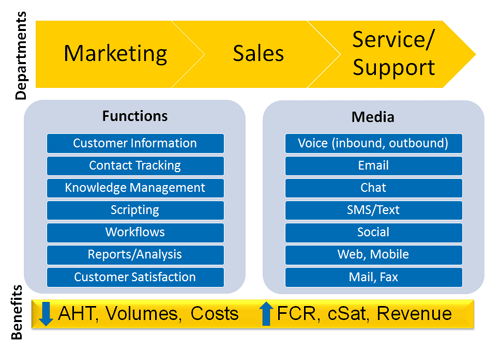If you are stuck in a world in which customer relationship management (CRM) software can only play in the sales sandbox, it’s time to think outside the box. CRM vendors have paved a road to operational efficiency that helps contact centers serve their customers in excellence, across media, while delivering a more satisfying experience for their agents and organizational peers. It also drives a sweeter bottom line for the center and the enterprise.
CRM breaks down interdepartmental process and data silos to establish a common view of the totality of each customer relationship. It coordinates and reports on activity across interaction channels (e.g., inbound calls, outbound calls, email, fax, chat, and social media) and organizational boundaries. It equips the enterprise to present itself as a united front to the outside world and behave like one internally.

CRM provides many benefits for the contact center:
Agents have access to key customer information at the start of each session. They don’t have to go on hunting expeditions across multiple systems or screens. Everything they need to launch a discussion is provided conveniently on the main screen.
Agents also have ready access to each customer’s services, recent purchases, and interaction history across a range media. It helps them come up to speed quickly on each relationship and tailor their conversations accordingly. [It also lowers average handle time (AHT)!]
Knowledge management features help respond to frequently asked questions, identify resources or processes to handle varying transaction types, and/or comb the enterprise library to respond to specific customer needs. It further reduces AHT and boosts first contact resolution (FCR) while promoting consistent responses across agents and self-service channels.
CRM solutions also support scripting to guide contact handling. Scripting makes sure agents convey the information you want during the interaction and creates the opportunity to amplify the relationship.
CRM applications have the ability to create workflows to process interactions from end-to-end. These workflows define “hand-offs” as well as follow-up routines to ensure fidelity to response time commitments, all based on business rules. If appropriate, reminders (and alarms) prompt agents to re-engage based on status or outcomes, or draw in supervisory attention.
CRM’s customer satisfaction tracking and reporting ties customer feedback to specific interactions and agents. When combined with the quality assurance program, it provides a 360 degree view of each agent’s performance.
Finally, CRM gives the marketing department a boost in market intelligence by providing access to a wealth of data on customers’ interactions with the enterprise. It helps analysts determine whether the company’s brand, products, and services are measuring up to expectations. It also provides guidance on the development of new products, services, and marketing campaigns.
So, if you think CRM is just a sales tool… think again!
